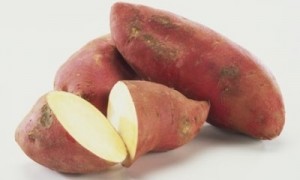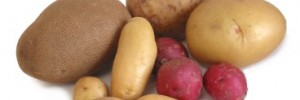The various types of potatoes –
Potatoes
Numerous potato varieties are cultivated in South America, but in North America, three basic types are found in the market: Russet/Idaho, white, and red. Russets are considered starchy potatoes and are preferred for baking, whites are best suited for roasting with meats or poultry, and reds, known as waxy potatoes, have the least starch and are good for simmering. New potatoes are immature, smaller versions of any mature potato variety. They have a delicate skin and waxy flesh that is ideal for simmering and for salads because they hold their shape. When selecting potatoes, look for those that are firm to the touch, and that have few eyes, good color, un-shriveled skin, and a round or oblong shape (irregular shapes result in more waste during peeling). They should all be about the same size to ensure even cooking. Russets should have a net-like texture on their skins with no hint of green coloration, which indicates exposure to sunlight and possible presence of the toxin solanine.
The varieties of each of the potatoes are as follows:
- Russet. Burbank, Centennial, and Norgold.
- White. Available in either long (White Rose) or round (Atlantic, Katandin, Kennebec, Superior).
- Red. Norland, Red LaSoda, and Red Pontiac.
- Others. Varieties such as Yukon Gold, a medium-starchy all-purpose potato, and a wide array of small, fingerling potatoes are becoming increasingly available in the market.
 Sweet Potatoes
Sweet Potatoes
There are two types of sweet potato: soft-fleshed, which tend to have a more orange flesh and are soft, moist, and sweet when cooked; and firm-fleshed, which are lighter in color and dry and mealy when cooked. Select sweet potatoes that have large, uniform shapes with no signs of discoloration, wrinkling, or drying. If they are too tapered or pointed at the ends, they may be difficult to peel.
Prominent sweet potato varieties include Beauregard, Jewel, Garnet, and Hernandez. Contrary to popular belief, sweet potatoes and yams are not the same vegetable. True yams are large, yellow to white tubers sold mostly in Latino markets. The “yam” sold in North American markets is actually a sweet potato that was developed in the 1930s by a horticulturist who wanted to distinguish it from other sweet potatoes. For many years, the produce and grocery industries have used the term “yam” to describe sweet potatoes with a bright orange color and sweet, moist flesh. The USDA requires that these sweet potatoes described as “yams” must also carry a “sweet potato” label.
